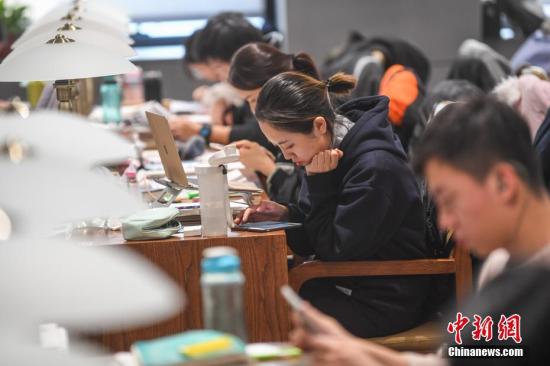


(Photo/Chinanews.com)
During the recent National Day holiday, many people took the time off to travel, while some people used this rare downtime to study. Recently, paid self-study rooms have appeared in Beijing, Shanghai, Shenzhen, Anhui and Shanxi. Since August, more than 10 paid self-study rooms in Shenzhen have opened in various districts and have seen strong demand, with some requiring reservation.
Paid self-study room becomes consumption hot spot
The self-study room is divided into many small partitions with tables and chairs. Each small partition can be rented for a few yuan per hour - for example, in Shenzhen, the average fee is 9 yuan per hour. Users can purchase a package, such as a week pass, month pass, or season pass, depending on their requirements.
Opening hours are generally from 8 a.m. to 11 or 12 p.m., which is not so different from the self-study rooms on campus. Paid self-study rooms usually provide power, tea and other services, but also put forward some requirements for consumers. For example, eating take-out in the office or occupying extra seats is not allowed.
One student, who was preparing for the postgraduate entrance examination, said that compared with the self-study room on campus, the paid self-study room is quieter and thus more efficient.
The market of a new consumer product
A founder of a paid self-study room in Shanxi said that he started the business because he couldn't get a seat at the library when he was at school.
"The establishment of self-study rooms provides a platform for everyone to achieve their goals effectively. Our target audiences are mainly students and people with different learning needs," he said.
An entrepreneur in Shanghai said that the average operating cost of an investment in this market is between several hundred thousand to one million yuan, and at the current profit rate, it would pay for itself within two years.
Xiong Bingqi, a scholar, believes that there is a demand for paid self-study rooms because they can provide corresponding services. However, from the perspective of improving social services, it is necessary to increase the openness of public resources to meet the needs of young people and students.
If new mechanisms can be explored, such as integrating the resources of schools and public venues in the community through third-party professional intermediaries, recruiting volunteers, and opening these resources to the society via methods such as membership, it can more effectively serve the nation.
 Fire brigade in Shanghai holds group wedding
Fire brigade in Shanghai holds group wedding Tourists enjoy ice sculptures in Datan Town, north China
Tourists enjoy ice sculptures in Datan Town, north China Sunset scenery of Dayan Pagoda in Xi'an
Sunset scenery of Dayan Pagoda in Xi'an Tourists have fun at scenic spot in Nanlong Town, NW China
Tourists have fun at scenic spot in Nanlong Town, NW China Harbin attracts tourists by making best use of ice in winter
Harbin attracts tourists by making best use of ice in winter In pics: FIS Alpine Ski Women's World Cup Slalom
In pics: FIS Alpine Ski Women's World Cup Slalom Black-necked cranes rest at reservoir in Lhunzhub County, Lhasa
Black-necked cranes rest at reservoir in Lhunzhub County, Lhasa China's FAST telescope will be available to foreign scientists in April
China's FAST telescope will be available to foreign scientists in April "She power" plays indispensable role in poverty alleviation
"She power" plays indispensable role in poverty alleviation Top 10 world news events of People's Daily in 2020
Top 10 world news events of People's Daily in 2020 Top 10 China news events of People's Daily in 2020
Top 10 China news events of People's Daily in 2020 Top 10 media buzzwords of 2020
Top 10 media buzzwords of 2020 Year-ender:10 major tourism stories of 2020
Year-ender:10 major tourism stories of 2020 No interference in Venezuelan issues
No interference in Venezuelan issues
 Biz prepares for trade spat
Biz prepares for trade spat
 Broadcasting Continent
Broadcasting Continent Australia wins Chinese CEOs as US loses
Australia wins Chinese CEOs as US loses